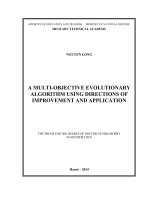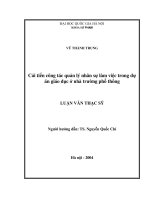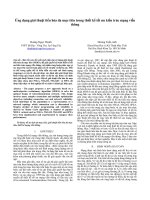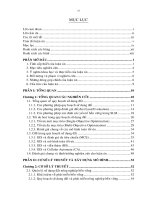Kết hợp bim và thuật toán tiến hóa đa mục tiêu (evolution algorith ea) nhằm tổ chức mặt bằng công trường và quản lý an toàn lao động trong dự án xây dựng
Bạn đang xem bản rút gọn của tài liệu. Xem và tải ngay bản đầy đủ của tài liệu tại đây (2.9 MB, 108 trang )
ĐẠI HỌC QUỐC GIA TP.HCM
TRƯỜNG ĐẠI HỌC BÁCH KHOA
------------------
HUỲNH PHÚ HẢI
KẾT HỢP BIM VÀ THUẬT TỐN TIẾN HĨA ĐA MỤC TIÊU
(EVOLUTION ALGORITH – EA) NHẰM TỔ CHỨC MẶT
BẰNG CÔNG TRƯỜNG VÀ QUẢN LÝ AN TOÀN LAO
ĐỘNG TRONG DỰ ÁN XÂY DỰNG
Chuyên ngành
Mã số
: QUẢN LÝ XÂY DỰNG
: 8580302
LUẬN VĂN THẠC SĨ
TP. HỒ CHÍ MINH, tháng 07 năm 2023
CƠNG TRÌNH ĐƯỢC HỒN THÀNH TẠI
TRƯỜNG ĐẠI HỌC BACH KHOA – ĐHQG -HCM
Cán bộ hướng dẫn khoa học 1:
PGS.TS. TRẦN ĐỨC HỌC
Chữ ký:
Cán bộ hướng dẫn khoa học 2:
TS. NGUYỄN ANH THƯ
Chữ ký:
Cán bộ chấm nhận xét 1:
TS. LÊ HOÀI LONG
Chữ ký:
Cán bộ chấm nhận xét 2:
TS. NGUYỄN VĂN TIẾP
Chữ ký:
Luận văn thạc sĩ được bảo vệ tại Trường Đại học Bách Khoa, ĐHQG Tp.HCM ngày
13 tháng 07 năm 2023.
Thành phần hội đồng đánh giá Luận văn thạc sĩ bao gồm:
1. Chủ tịch hội đồng:
PGS.TS Lương Đức Long
2. Thư ký hội đồng:
PGS.TS Đỗ Tiến Sỹ
3. Ủy viên phản biện 1:
TS. Lê Hoài Long
4. Ủy viên phản biện 2:
TS. Nguyễn Văn Tiếp
5. Ủy viên hội đồng:
TS. Đặng Ngọc Châu
Xác nhận của Chủ tịch Hội đồng đánh giá Luận văn và Trưởng Khoa quản lý chuyên
ngành sau khi luận văn được sửa chữa (nếu có).
CHỦ TỊCH HỘI ĐỒNG
TRƯỞNG KHOA
KỸ THUẬT XÂY DỰNG
ĐẠI HỌC QUỐC GIA TP.HCM
TRƯỜNG ĐẠI HỌC BÁCH KHOA
CỘNG HÒA XÃ HỘI CHỦ NGHĨA VIỆT NAM
Độc lập – Tự do – Hạnh phúc
NHIỆM VỤ LUẬN VĂN THẠC SĨ
Họ tên học viên: HUỲNH PHÚ HẢI
Ngày, tháng, năm sinh: 24/03/1997
Chuyên ngành: Quản lý xây dựng
I.
TÊN ĐỀ TÀI:
MSHV: 2170248
Nơi sinh: Tp. Hồ Chí Minh
KẾT HỢP BIM VÀ THUẬT TỐN TIẾN HĨA ĐA MỤC TIÊU (EVOLUTION
ALGORITH – EA) NHẰM TỔ CHỨC MẶT BẰNG CÔNG TRƯỜNG VÀ QUẢN
LÝ AN TOÀN LAO ĐỘNG TRONG DỰ ÁN XÂY DỰNG.
INTEGRATING BUILDING INFORMATION MODELING (BIM) WITH A
MULTI-OBJECTIVE EVOLUTION ALGORITHM (EA) TO OPTIMIZE
CONSTRUCTION SITE LAYOUT AND MANAGE LABOR SAFETY IN
CONSTRUCTION PROJECTS
II.
NHIỆM VỤ VÀ NỘI DUNG:
1.Tìm hiểu các thuật tốn EAs bao gồm: tối ưu bầy đàn (PSO) và thuật toán di truyền
(NSGA_II).
2.Xác định và giải quyết hàm mục tiêu bài tốn bố trí cơ sở vật chất và an tồn lao
động đối với trường hợp rơi vật tư trong quá trình vận chuyển.
3.Kết hợp BIM và các thuật tốn EAs, tạo ra cơng cụ giúp tối ưu hố mặt bằng cơng
trường và quản lý an tồn lao động.
III.
NGÀY GIAO NHIỄM VỤ:
06/02/2023
IV.
NGÀY HOÀN THÀNH NHIỆM VỤ:
12/06/2023
V.
CÁN BỘ HƯỚNG DẪN: PGS.TS. TRẦN ĐỨC HỌC và TS. NGUYỄN ANH
THƯ
Tp. Hồ Chí Minh, ngày 12 tháng 06 năm 2023
CÁN BỘ HƯỚNG DẪN
CÁN BỘ HƯỚNG DẪN
CHỦ NHIỆM BỘ MÔN
PGS.TS. TRẦN ĐỨC HỌC
TS. NGUYỄN ANH THƯ
TS. LÊ HOÀI LONG
TRƯỞNG KHOA KỸ THUẬT XÂY DỰNG
i
LỜI CẢM ƠN
Tôi xin gửi lời cảm ơn sâu sắc nhất đến thầy cô hướng dẫn, thầy PGS.TS.
Trần Đức Học và TS. Nguyễn Anh Thư, vì sự hướng dẫn và hỗ trợ quý báu của họ
trong suốt quá trình thực hiện luận văn thạc sĩ của tôi về "KẾT HỢP BIM VÀ
THUẬT TỐN TIẾN HĨA ĐA MỤC TIÊU (EVOLUTION ALGORITHM - EA)
NHẰM TỔ CHỨC MẶT BẰNG CÔNG TRƯỜNG VÀ QUẢN LÝ AN TOÀN
LAO ĐỘNG TRONG DỰ ÁN XÂY DỰNG."
Kiến thức và sự nhận biết của họ đã đóng vai trị quan trọng trong việc hình
thành nghiên cứu này, và sự khích lệ của họ đã thúc đẩy tơi nỗ lực hết mình. Tơi
thật sự biết ơn sự kiên nhẫn, hiểu biết và sự hướng dẫn của thầy cơ.
Cùng với đó tôi muốn gửi lời cảm ơn đến Trường Đại học Bách Khoa, Đại
học Quốc gia, đã cung cấp cho tôi một môi trường học tập tuyệt vời và cơ hội để
thực hiện nghiên cứu này.
Tôi cũng muốn gửi lời cảm ơn đến khoa Quản lý Xây dựng đã tạo ra một
mơi trường học thuật sáng tạo, cũng như phịng thí nghiệm mơ phỏng thơng tin
cơng trình BIM (BIMLab) và đến các bạn đồng niên của tơi vì sự đồng lịng và
những cuộc thảo luận trí tuệ. Cuộc hành trình này sẽ khơng giống như vậy nếu
khơng có mọi người .
Cuối cùng, tơi muốn dành cơng trình này cho gia đình của tơi vì tình u và
sự hỗ trợ khơng ngừng nghỉ của họ trong suốt quá trình học tập của tôi. Niềm tin
của họ vào khả năng của tôi đã là nguồn sức mạnh và cảm hứng không ngừng.
Và lần nữa cảm ơn tất cả mọi người đã là một phần của cuộc hành trình này.
Tp. Hồ Chí Minh, ngày 08 tháng 02 năm 2023
Huỳnh Phú Hải
Master Student: Huynh Phu Hai
Student Code: 2170248
ii
TĨM TẮT
Bước khởi đầu quan trọng nhất trong q trình thi cơng xây dựng cơng trình là lập
kế hoạch bố trí mặt bằng cơng trường. Thành cơng của bước này sẽ góp phần đẩy
nhanh tiến độ dự án. Từ đó vấn đề bố trí mặt bằng trong cơng trường xây dung được
chú ý, đã có nhiều phương pháp giải quyết từ trực quan dựa trên kinh nghiệm cho
đến sử dụng các thuật tốn máy tính hiện đại. Tuy nhiên, việc tìm ra giải pháp tối ưu
cho bài tốn này vẫn là thách thức lớn với các nhà quản lý dự án bởi các dự án ngày
càng phức tạp và có nhiều mục tiêu khác nhau cần cân bằng. Với khả năng kết hợp
mơ hình thơng tin (BIM) và thuật tốn tiến hoá tối ưu (EAs) đang được coi là xu
hướng tất yếu trong tương lai của ngành xây dựng nhằm giải quyết bài tốn về tối
ưu trong cơng trình xây dựng. BIM cung cấp khả năng mơ hình hóa thơng tin chi
tiết, chính xác về cơng trình. Trong khi đó, EAs với các thuật tốn tối ưu hóa tiên
tiến có thể xử lý các bài toán kinh doanh phức tạp, đưa ra các giải pháp tối ưu trong
thời gian thực. Trong nghiên cứu này, phát triển mơ hình tối ưu hóa bố trí mặt bằng
cơng trường nhằm mục đích giảm rủi ro giữa các luồng hoạt động và tối ưu hố
bình đồ cơng trường được phát triển. Đề tài nghiên cứu các thuật tốn tối ưu hóa
tiến hóa như PSO và NSGA-II, sau đó kết hợp với BIM để xây dựng mơ hình tốn
học và cơng cụ hỗ trợ ra quyết định cho bài tốn tổ chức mặt bằng cơng trường.
Master Student: Huynh Phu Hai
Student Code: 2170248
ii
ABSTRACT
The most important initial step in the construction process of a project is planning
the layout of the construction site. The success of this step contributes to
accelerating the project's progress. Thus, the layout arrangement in the construction
site has been given attention, with various solutions proposed, ranging from
intuitive approaches based on experience to the use of modern computer algorithms.
However, finding an optimal solution for this problem remains a significant
challenge for project managers due to the increasing complexity of projects and the
need to balance various objectives. Combining Building Information Modeling
(BIM) and Evolutionary Algorithms (EAs) is considered an inevitable trend in the
future of the construction industry to address optimization problems in construction
projects. BIM provides the ability to model detailed, accurate information about the
project, while EAs with advanced optimization algorithms can handle complex
business problems, offering optimal solutions in real-time. In this study, a layout
optimization model for construction sites is developed with the aim of reducing the
risks between activity flows and optimizing the site's layout. The research topic
investigates evolutionary optimization algorithms such as PSO and NSGA-II, and
then combines them with BIM to construct a mathematical model and decision
support tool for the construction site layout organization problem.
Master Student: Huynh Phu Hai
Student Code: 2170248
iii
LỜI CAM ĐOAN
Tôi xin cam đoan đây là luận văn do chính tơi thực hiện dưới sự hướng dẫn của
PGS.TS. Trần Đức Học và TS. Nguyễn Anh Thư
Các kết quả của luận văn là đúng sự thật và chưa được công bố ở các nghiên cứu
khác.
Tôi xin chịu trách nhiệm về cơng việc thực hiện của mình.
Tp. Hồ Chí Minh, ngày 08 tháng 02 năm 2023
Huỳnh Phú Hải
Master Student: Huynh Phu Hai
Student Code: 2170248
iv
TABLE OF CONTENTS
TABLE OF CONTENTS .......................................................................................... iv
LIST OF ABBREVIATIONS ................................................................................... vi
LIST OF TABLES ................................................................................................... vii
LIST OF FIGURES................................................................................................. viii
LIST OF EQUATION.................................................................................................x
CHAPTER 1: INTRODUCTION ...............................................................................1
1.1. PROBLEM STATEMENT ..................................................................................1
1.1.1 Construction site layout ................................................................................3
1.1.2 Construction site safety ................................................................................4
1.1.3 Evolution Algorithm - EA ............................................................................8
1.1.4 EA Assessment: ..........................................................................................10
1.1.5 Building Information Modelling ................................................................12
1.1.6 Combining BIM and EA.............................................................................18
1.2. PROBLEM STATEMENT ................................................................................18
1.2.1. Thesis related question ..............................................................................18
1.3. RESEARCH OBJECTIVES ..............................................................................19
1.3.1. Research Objective ....................................................................................19
1.3.2. Research Scope ..........................................................................................19
1.3.3. Research contributions ..............................................................................19
CHAPTER 2: LITTERATURE REVIEW ................................................................21
2.1 CONSTRUCTION SITE LAYOUT AND CONSTRUCTION SAFETY .........21
2.1.1 Construction site layout planning ...............................................................21
2.1.2 Construction safety prevention[41]: ...........................................................27
2.2 MULTI – OBJECTIVE EVOLUTION ALGORITHM .....................................28
Master Student: Huynh Phu Hai
Student Code: 2170248
v
2.2.1 Multi – Objective optimization - MOO: .....................................................28
2.2.2 Step to analyze by EA. ...............................................................................31
2.2.3 Particle Swarm Optimization (PSO) inspiration. .......................................33
2.2.4 Particle Swarm Optimization (PSO). .........................................................34
2.3 RELATED STUDIES .........................................................................................37
2.3.1 Metaheuristics Algorithm ...........................................................................37
2.3.2 Evolutional Algorithm ................................................................................39
2.3.3 BIM in construction site layout ..................................................................40
CHAPTER 3: METHODOLOGY ............................................................................42
3.1 THESIS WORKFLOW .......................................................................................42
CHAPTER 4: CASE STUDY ...................................................................................57
4.1 OBJECTIVE FUNCTION AND PARAMETER ...............................................57
4.1.1 Project Parameter ........................................................................................57
4.1.2 PSO in MOO: .............................................................................................64
4.1.3 Optimize result: ..........................................................................................64
4.1.4 MOPSO comparison with NSGA II ...........................................................74
4.2 RESEARCH FINDDING....................................................................................82
4.2.1 EA – BIM Intergration ...............................................................................82
CHAPTER 5: CONCLUSIONS ...............................................................................85
5.1 Conclusion: .........................................................................................................85
5.2 Limitation: ...........................................................................................................86
5.3 Future research: ...................................................................................................86
REFFENCES.............................................................................................................88
Master Student: Huynh Phu Hai
Student Code: 2170248
vi
LIST OF ABBREVIATIONS
BIM
Mơ hình thơng tin cơng trình
MOPSO
Thuật tốn đa mục tiêu bầy đàn Multi Objective Particle Swarm
Optimization
NSGA II
Thuật toán di truyền khơng None Dominated Sorting Genetic
Algorithm
vượt trội
OSH
An Tồn Lao động
Occupational Safety and Health
IT
Cơng nghệ thơng tin
Information Technology
EA
Thuật Tốn tiến hóa
Evolution Algorithm
CSLP
Sắp xếp bình đồ cơng trường
Construction Site Layout Planning
API
Giao diện lập trình ứng dụng
Application Programming Interface
CSC
Hệ số an tồn của cẩu trục
Crane Safety Criterion
MCDC
Ra quyết định đa tiêu chí
Multiple Criteria Decision Making
Master Student: Huynh Phu Hai
Building Information Modelling
Student Code: 2170248
vii
LIST OF TABLES
Table 1-1: Comparison of occupational accident situations in 2022 and 2021 in
areas with labor relations [6]. ......................................................................................6
Table 1-2: Pros and cons for Algorithm in EA .........................................................12
Table 2-1: List of temporary facility .........................................................................22
Table 2-2: Meta – heuristics in CSLP related study .................................................38
Table 2-3: Evolution Algorithm in CSLP related studies .........................................39
Table 2-4: Related studies in integrate BIM in construction site layout...................40
Table 3-1: Project Temporary facility project properties..........................................44
Table 3-2 Sensitivity of Facility to Falling Objects. .................................................51
Table 4-1 Hazard Degree Matrix ..............................................................................60
Table 4-2: Adjacent distance matrix of temporary facility Loop 1 (F1)...................61
Table 4-3: Temporary facilities Zone identified Loop 1...........................................62
Table 4-4: CSC Coefficient in Loop 1 (F2) ..............................................................62
Table 4-5: MOPSO output after 16-time optimization in project in loop 2..............66
Table 4-6: MOPSO output after 16-time optimization in project in loop 24............67
Table 4-7: MOPSO output after 16-time optimization in project in loop 25............68
Table 4-8: MOPSO output after 16-time optimization in project in loop 28............69
Table 4-9: MOPSO output after 16-time optimization in project in loop 33............70
Table 4-10: MOPSO output after 16-time optimization in project in loop 38..........71
Table 4-11: MOPSO output after 16-time optimization in project in loop 43..........72
Table 4-12: MOPSO output after 16-time optimization in project in loop 46..........73
Table 4-13: Output comparison between MOPSO and NSGA II Loop 15 ..............75
Table 4-14: Output comparison between MOPSO and NSGA II Loop 40 ..............76
Table 4-15: Output comparison between MOPSO and NSGA II Loop 24 ..............78
Table 4-16: Descriptive Statistics .............................................................................80
Master Student: Huynh Phu Hai
Student Code: 2170248
viii
LIST OF FIGURES
Figure 1-1: Evolutionary algorithms and their subtypes [16]. ..................................10
Figure 1-2: Building information modeling construction life cycle[24]. .................14
Figure 1-3: Conventional and BIM communication between stakeholders [25] ......14
Figure 1-4: BIM Environment ..................................................................................18
Figure 2-1: Temporary facility in BIM of CSLP, [29] .............................................22
Figure 2-2: BIM 3D procedure .................................................................................25
Figure 2-3: Top View Construction site layout ........................................................25
Figure 2-4: 3D Construction site layout ....................................................................26
Figure 2-5: Render Construction site layout .............................................................26
Figure 2-6: Pareto Example ......................................................................................31
Figure 2-7: Evolution Algorithm Flowchart[45] ......................................................33
Figure 2-8: Eberhart (Left) & Kenedy (Right)..........................................................34
Figure 2-9: PSO Flowchart .......................................................................................35
Figure 2-10: PSO Pseudo code .................................................................................37
Figure 3-1: Thesis workflow .....................................................................................42
Figure 3-2: Interaction between facility ....................................................................44
Figure 3-3: Shortest route distance compared to Euclidean distance. ......................45
Figure 3-4: Revit Api Add-in Workflow ..................................................................46
Figure 3-5: Danger ring of crane ...............................................................................48
Figure 3-6: Hazard Degree table measurement.........................................................51
Figure 3-7: PSO – NSGA II for multi objective optimization flowchart .................54
Figure 4-1: F1, F2 Data Schema ...............................................................................58
Figure 4-2: 3D BIM Sunrise construction site ..........................................................58
Figure 4-3: 3D sunrise construction floor plan .........................................................59
Figure 4-4 Presentive Placement of temporary facility (Grey is the TFs and white is
replacement cube – 2 x2 m) ......................................................................................61
Master Student: Huynh Phu Hai
Student Code: 2170248
ix
Figure 4-5: PSO Parameter setting. ...........................................................................65
Figure 4-6: Pareto Using MOPSO in loop 2 ...........................................................66
Figure 4-7: Construction site planning in loop 2 .....................................................66
Figure 4-8: Pareto Using MOPSO in loop 24. .........................................................67
Figure 4-9: Construction site planning in loop 24 ....................................................67
Figure 4-10: Construction site planning in loop 25 ..................................................68
Figure 4-11: Pareto Using MOPSO in loop 25. .......................................................68
Figure 4-12: Construction site planning in loop 28 ..................................................69
Figure 4-13: Pareto Using MOPSO in loop 28. .......................................................69
Figure 4-14: Construction site planning in loop 33 ..................................................70
Figure 4-15: Pareto Using MOPSO in loop 33. .......................................................70
Figure 4-16: Construction site planning in loop 38 ..................................................71
Figure 4-17: Pareto Using MOPSO in loop 38. .......................................................71
Figure 4-18: Construction site planning in loop 43 ..................................................72
Figure 4-19: Pareto Using MOPSO in loop 43. .......................................................72
Figure 4-20: Construction site planning in loop 46 ..................................................73
Figure 4-21: Pareto Using MOPSO in loop 46. .......................................................73
Figure 4-22: MOPSO and NSGA II Parameter setting. ............................................75
Figure 4-23: Comparison Chart between MOPSO and NSGA Loop 15 ..................76
Figure 4-24: Comparison Chart between MOPSO and NSGA Loop 40 ..................78
Figure 4-25: Comparison Chart between MOPSO and NSGA Loop 24 ..................79
Figure 4-26: Schematic layout drawing by Ning, et al. [55] ...................................83
Figure 4-27: Automation in Construction Layout.....................................................84
Master Student: Huynh Phu Hai
Student Code: 2170248
x
LIST OF EQUATION
𝑚𝑚𝑚𝑚𝑚𝑚𝑚𝑚𝑚𝑚𝑚𝑚𝑚𝑚(𝑋𝑋)𝑥𝑥 ∈ 𝐷𝐷 = [𝑓𝑓1𝑋𝑋, 𝑓𝑓2𝑋𝑋, … , 𝑓𝑓𝑘𝑘𝑘𝑘] Equation 2-1 ......................................29
Equation 2-2 ..............................................................................................................30
Equation 2-3 ..............................................................................................................30
Equation 2-4 ..............................................................................................................30
Equation 2-5 ..............................................................................................................36
Equation 2-6 ..............................................................................................................36
Equation 3-1 ..............................................................................................................49
Equation 3-2 ..............................................................................................................49
Equation 3-3 ..............................................................................................................50
Equation 3-4 ..............................................................................................................50
Equation 3-5 ..............................................................................................................51
Equation 3-6 ..............................................................................................................52
Equation 4-1 ..............................................................................................................57
Equation 4-2 ..............................................................................................................64
Master Student: Huynh Phu Hai
Student Code: 2170248
CHAPTER 1: INTRODUCTION
1.1. PROBLEM STATEMENT
As construction projects become more complex, design and construction methods
also become more advanced [1], and Building Information Modeling (BIM) has been one
of the significant advancements in the construction industry in recent years. BIM can help
designers, construction managers, and contractors complete their work more efficiently,
paving the way for a more professional construction industry. BIM enables contractors
and project stakeholders to pay more attention to occupational safety and health (OSH),
making it easier to visualize the impact of construction sites and changes in the work
environment on OSH. BIM facilitates better communication among stakeholders
regarding OSH issues. With the development of BIM, the entire project lifecycle can now
be simulated in a virtual environment, where all safety information can also be integrated.
BIM is widely applied in construction management and OSH management. It is
integrated into planning, decision-making support, management, and site supervision.
Efforts to apply BIM in OSH management include:
• Digitizing and planning construction according to the project schedule while
managing OSH, checking the compatibility of OSH equipment,
• Ensuring that the construction site and its components can be built with minimal
accident risk and adequate conditions for implementing appropriate OSH measures,
• Creating a visual, easy-to-understand OSH plan that helps all stakeholders, including
construction workers, understand the process,
• Updating accurate information on the construction site to avoid conflicts and delays
when changes occur.
Despite the benefits BIM brings to the construction industry and its support in
making fast and accurate decisions, the application of BIM in temporary works and
structures is not yet widespread. Temporary structures such as scaffolding, fall protection
Master Student: Huynh Phu Hai - 2170248
Pages 1 | 97
nets, temporary stairs, tower cranes, and hoists significantly impact OSH on construction
sites, and these tasks are usually fully represented in traditional construction plans.
The application of BIM technology in Vietnam is still quite new, and BIM has
only gained significant attention in the Vietnamese construction industry in recent years.
There are not many projects that have integrated BIM during the construction phase, and
BIM has not yet been fully integrated into project workflows. Several studies [2-4] have
identified barriers to the widespread adoption of BIM in the construction industry, such
as:
• Lack of skilled BIM human resources
• Lack of structured training and education on popular BIM software
• Absence of standards, guidelines, and legal regulations about BIM
• Customers not demanding the use of BIM in projects.
• High cost of software and expensive IT infrastructure requirements
The integration BIM and automated Evolution Algorithm in the optimization of
construction site layout, as well as crane safety regarding falling objects, is currently
under-researched. This lack of scholarly attention presents a significant problem as these
elements are critical for improving efficiency and safety measures in the construction
industry.
Despite the importance of these areas, there has been a noticeable scarcity of
studies dedicated to each field. The use of BIM in construction site layout optimization
and crane safety is an emerging field of inquiry, yet its potential in ensuring work
efficiency and worker safety is immense. Similarly, the application of automated
Evolution Algorithm in construction management holds promising prospects for
enhancing project performance and reducing the likelihood of preventable accidents.
Even more concerning is the fact that over the past three years, there have only
been 28 [5] research studies related to construction site optimization. This number is
Master Student: Huynh Phu Hai - 2170248
Pages 2 | 97
remarkably low considering the pressing need for improvements in construction site
operations and safety measures.
In summary, there is a significant gap in research concerning the integration of
BIM and automated Evolution Algorithm in optimizing construction site layout and
enhancing crane safety. This lack of study not only hampers the advancement of
knowledge in these areas but also potentially limits the progress in construction site
operational efficiency and safety. Therefore, it is imperative to address this research
deficit and explore the potential benefits and challenges of integrating these technological
advancements in construction industry practices.
1.1.1 Construction site layout
The construction site layout plays a pivotal role in the successful execution of
construction projects, encompassing the strategic organization and allocation of
resources, materials, workforce, and temporary facilities within a defined area. A wellplanned layout can greatly contribute to improved productivity, safety, and efficiency
throughout the construction process. This introductory article will delve into the
significance of construction site layout planning, essential considerations when devising a
layout, and the wide range of tools and methodologies employed to optimize the layout
for maximum effectiveness and cost-efficiency.
Effective site layout planning entails the thoughtful positioning of various
components, including storage spaces, equipment, temporary facilities, and access routes,
to ensure a seamless workflow and minimize disruptions. Proper planning can lead to a
reduction in construction time, cost savings, enhanced safety measures, and superior
environmental performance. Several factors must be considered when designing a
construction site layout, such as the size and shape of the site, topography, soil
conditions, environmental considerations, and local regulations. Furthermore, the layout
should remain flexible and adaptable, allowing for adjustments in response to changes in
project requirements or unforeseen circumstances.
Master Student: Huynh Phu Hai - 2170248
Pages 3 | 97
A wide array of tools and techniques are at the disposal of construction
professionals to aid in the development and optimization of construction site layouts.
These range from manual methods to advanced computer-based systems. For instance,
heuristic algorithms, linear programming, and simulation-based approaches have all been
utilized to optimize site layout planning.
1.1.2 Construction site safety
In recent years, Vietnam's construction industry has experienced accelerated
expansion, prompting a greater emphasis on safety measures and regulations. The
Vietnam Department of Safety emphasizes the significance of proper planning and risk
management throughout the lifecycle of a construction project. This includes identifying,
assessing, and mitigating potential hazards, as well as implementing effective safety
training programs for employees. In addition, the department stresses the importance of
open communication and collaboration between stakeholders to ensure that safety
remains a top priority throughout all phases of construction.
Additionally, the Vietnam Department of Safety emphasizes the significance of
implementing modern technologies and innovative practices to enhance construction
safety. These technologies include Building Information Modeling (BIM), drones for site
inspections, devices for monitoring the health of employees, and advanced materials that
improve structural integrity. The implementation of these tools and techniques not only
contributes to a secure work environment, but also increases productivity, decreases
project costs, and enhances the overall quality of the project.
According to situation of occupation accident issued in 01st, April 2023 by the
Ministry of Labor, Invalids and Social Affairs[6] informs various industries and localities
about the situation of occupational accidents in 2022 and some key solutions to
proactively prevent incidents and occupational accidents in 2023.
In 2022, the majority of provinces and cities in Vietnam have reported alarming rates
of occupational accidents, injuries, and fatalities. There were more than 7,700 incidents at
Master Student: Huynh Phu Hai - 2170248
Pages 4 | 97
work, nearly 8,000 total casualties, more than 700 fatalities, and more than 1,600 severe
injuries. The majority of those killed had formal employment contracts[6].
While fatalities decreased marginally from 2021, the total accident rate increased by
nearly 19%, the number of casualties increased by 19%, and the number of severe
injuries rose by 11%. Accidents, injuries, and fatalities affect employed employees
disproportionately more than those in precarious or contactless employment. However,
vulnerable employees remain at risk[6].
Key statistics include:
• 7,718 occupational accidents, an increase of 1,214 from 2021 (18.7%)
• 7,923 total fatalities, an increase of 1,265 (19%) from 2021
• 720 fatal incidents, down 29 (a decrease of 3.9%) from 2021.
• 754 fatalities, 32 fewer than in 2021 (a decrease of 4.1%)
• 1,647 severe injuries, an increase of 162 from 2021 (10.9%)
The preponderance of accidents, injuries, and fatalities involved contract workers:
• 568 catastrophic incidents and 595 fatalities involving contract employees.
• 1,466 significant injuries sustained by contract employees.
Although reduced in number, unemployed laborers also confronted significant
dangers[6]:
• 152 catastrophic accidents and 159 unemployed employees lost their lives.
• 181 serious injuries to independent contractors
In conclusion, Vietnam is experiencing an alarming increase in occupational hazards,
particularly for employees in standard jobs. Almost 20% more accidents and fatalities
occurred in 2022 than in 2021, according to data from the majority of provinces and
cities. Hundreds of catastrophic incidents resulted in over 750 deaths and over 1,600
severe injuries, despite a modest decline in fatalities. These statistics indicate an
imperative need to prioritize health and safety through policy, workplace interventions,
Master Student: Huynh Phu Hai - 2170248
Pages 5 | 97
and cultural shifts. No one should suffer or die from work-related causes that are
preventable, regardless of employment status or working conditions. Comprehensive and
equitable reform could assist in mitigating this escalating crisis, bolster productivity and
well-being, and safeguard Vietnam's labor force, the source of its economic vitality.
Every life has intrinsic value, and no one deserves to be put in danger to earn a living. To
safeguard the nation's human resources and shared prosperity, occupational hazards
necessitate a cross-sector cooperative response.
Table 1-1: Comparison of occupational accident situations in 2022 and 2021 in areas
with labor relations [6].
N
Statistical Indicator
2021
2022
Increase (+) Decrease (-)
1
Number of cases
5,797
7,187
+1,390 (+23.98%)
2
Number of victims
5,910
7,366
+1,456 (+24.63%)
3
Number of cases with fatalities
574
568
-06 (-1.05%)
4
Number of fatalities
602
595
-07 (-1.16%)
5
Number of seriously injured
1,226
1,466
+240 (+19.6%)
Construction site safety planning (CSSP) is an essential part of organizing
construction work. Although regulations for safety at construction sites exist, workers
receive safety training, and efforts have been made to issue legal documents on safety in
construction, the rate of accidents and casualties caused by occupational accidents in the
construction industry remains the highest - Labor Safety Bureau - Ministry of Labor,
Invalids and Social Affairs. Inappropriate organization and supervision, lack of
communication among stakeholders, insufficient attention to training and practicing
safety, and lack of necessary safety measures are the main factors leading to accidents
[7]. Site safety is often assumed to be the responsibility of the contractor, while design
greatly influences construction methods and progress. Designers rarely consider the risk
Master Student: Huynh Phu Hai - 2170248
Pages 6 | 97
of safety loss in their designs. Design work significantly affects construction methods,
progress, and safety.
Many contractors do not even develop a safety plan for their sites but only issue
general safety guidelines. Currently, most companies manage safety according to the
rules outlined in OSHA, while some companies establish their safety rules based on
experience, habits, and common situations. Traditional safety planning methods often
rely on manually inspecting locations suspected of having safety risks, which is laborintensive, time-consuming, and ineffective. The connection between construction tasks
and safety planning is unclear, and many contractors rely on 2D drawings to assess risks.
These assessments depend on the experience of safety engineers. Contractors typically
use CAD-2D for organizing construction planning and safety planning. This method uses
static drawings, independent of the design. Descriptions of construction projects based on
CAD-2D do not accurately represent actual site conditions and are not suitable for
identifying risks that cause accidents at construction sites [1]. Construction safety
management can be summarized in the following areas:
1. Legal regulations on safety, site regulations, standards, and safety guidelines,
2. Management and design regulations supervised by the investor,
3. Design that considers its related hazards and risks of causing accidents during
construction,
4. Managing accident risks during construction based on approved construction
measures,
5. Developing a site safety management plan and managing safety during the
project operation phase [8].
The advent and development of Building Information Modeling (BIM) in the
construction industry have changed our approach to safety issues. BIM is widely
recognized as a tool that helps stakeholders improve communication within the site,
enhance the quality of information for faster decision-making, shorten construction time,
Master Student: Huynh Phu Hai - 2170248
Pages 7 | 97
and reduce costs at all stages of the project lifecycle. One of the strengths of BIM
compared to traditional 2D and 3D CAD is that in addition to 3D modeling and
management capabilities, BIM also provides essential information for project
stakeholders, helping to present drawings, reports, and statistics automatically and easily
updated when changes occur. BIM also enables construction simulation, schedule
integration, and equipment management, thereby helping managers make decisions more
quickly and easily [9]. The greatest benefit of BIM is the visualization of 3D models,
which are easier to understand than traditional 2D drawings, even for those with limited
technical knowledge. This ease of understanding eases the identification of safety risks.
Furthermore, BIM can integrate schedule information into the virtual model of the
project. This schedule is used to simulate the construction process according to the
project's development timeline, giving project participants an overview of how the
construction is built over time. BIM shows greater potential than what BIM can do during
the design phase; with BIM, managers can combine construction management and
equipment management and operation in a virtual model parallel to the actual project.
BIM can contribute to a project's success by increasing the efficiency of construction
schedule management, budget, quality, and risk reduction through real-time simulations
[10].
1.1.3 Evolution Algorithm - EA
At present, the complexity of real-world applications has significantly increased.
Complex problems such as automation, operational research, decision making, bio
informatics machine learning, and data mining are complicated to solve [11, 12]. By that
Evolutionary Computation is a proposed method for addressing such complex problems
that is inspired by Darwin's natural evolutionary process. As demonstrated in (Figure
1-1), an overview of EAs and their subtypes. EAs are garnering special attention,
particularly with this technique it is being used to solve actual problems. Evolutionary
Algorithms have become an important tool for searching, optimizing, and offering
solutions for complicated problems [13] over the past two decades. EA is founded on the
Master Student: Huynh Phu Hai - 2170248
Pages 8 | 97
principle of survival of the strongest (i.e., evolution). It is significantly influenced by
Darwin's theory of evolution [14], in which a system changes incrementally over time. It
operates on several fundamental principles, including the presence of one or more distinct
populations competing for limited resources. The construction industry strives
continually to optimize construction site layout planning, a crucial aspect of project
management, in order to increase productivity, reduce construction time and costs, and
enhance safety measures. In recent years, evolutionary algorithms have emerged as a
promising strategy for addressing the dynamic and complex character of construction
initiatives. These algorithms, which were inspired by the natural selection and evolution
processes, have demonstrated their ability to tackle optimization problems in a variety of
disciplines, including construction site layouts.
In order to survive in the natural world, organisms must adapt to their
environment; this process is known as evolution. At the time of reproduction, the
characteristics that improve an individual's ability to compete are preserved, while the
inferior factors are eliminated. These characteristics are governed by genes, and
chromosomes are collections of these genes. Only the most fit individuals endure to the
next generation, and their finest DNA are passed on to their descendants via
recombination. This natural selection and optimization procedure resulted in the
development of the "evolutionary algorithm". Due to the adaptable nature and robust
behavior inherited from Evolutionary Computation, it has become a prevalent problemsolving technique for global optimization issues. Numerous high-complexity applications
can utilize it with effectiveness [15].
Evolutionary algorithms, which include Genetic Algorithms (GA), Particle Swarm
Optimization (PSO), and Ant Colony Optimization (ACO), are capable of identifying
optimal solutions in large, multi-objective problem spaces, which makes them ideal for
solving complex construction site layout problems. The primary objective of using
EAs in construction site layout planning is to identify the most efficient arrangement of
temporary facilities, equipment, and materials while balancing multiple objectives,
Master Student: Huynh Phu Hai - 2170248
Pages 9 | 97
including minimizing material handling costs, reducing construction time, and ensuring
site safety.
This research aims to explore the potential of evolutionary algorithms in
improving construction site layout planning also with enhancing the construction site
safety due to crane distance falling object, highlighting their advantages over traditional
methods. By harnessing the power of these advanced optimization techniques,
construction professionals can effectively tackle the challenges associated with site layout
planning, leading to more efficient, cost-effective, and safer construction projects.
Figure 1-1: Evolutionary algorithms and their subtypes [16].
1.1.4 EA Assessment:
Due to multiple benefits over conventional method and optimization techniques,
EAs has been extensively implemented in numerous applications to solve complex
problems [17].
EAs are inspired by natural evolution, which makes them basic, adaptable, and
capable of utilizing prior knowledge. This increases efficiency and reduces the search
space. However, EAs are only applicable when candidates can be independently
evaluated.
Master Student: Huynh Phu Hai - 2170248
Pages 10 | 97
1. EAs employ computational methods to solve problems involving continuous
values and constraints. EAs adapt to dynamic, altering environments without
requiring a complete restart of the analysis, unlike conventional methods. They are
resistant to continuous change.
2. EAs incorporate problem-specific knowledge, which enhances performance. Less
informative methods will not perform as well. Prior information assists in limiting
the search space by excluding less optimal regions.
3. EAs utilize computational techniques to accommodate continuous values and
constraint functions. Traditional methods are incapable of handling dynamism and
must be restarted to discover new solutions when environments change.
4. EAs are adaptive to environments of dynamic analysis. In contrast to the adaptable
EAs, traditional optimization techniques are not impervious to change and require
rerunning analyses to solve new problems when environments change.
In addition to its many benefits, EA has several disadvantages Table 1-2, such as
not always being able to guarantee an optimal solution for a particular problem within the
predicted time, possibly requiring parameter adjustment through trial and error, and
requiring substantial computational resources.
Master Student: Huynh Phu Hai - 2170248
Pages 11 | 97









